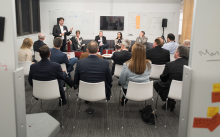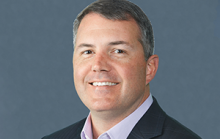In the often fuzzy realm of digital transformation, CEOs have made one fact clear to CIOs: You’re now responsible for helping us find new ways to make money. Recent Harvey Nash research found 64 percent of CIOs say their CEO wants IT to focus on making money, not saving it. But bringing a revenue-generation focus to your IT organization creates big changes – to culture, structure, hiring, and other areas.

To help you address those challenges, we’ve been exploring revenue-generation strategies for almost a year, starting with our research report, "Revenue-Generating CIOs: Smart Strategies to Grow the Business," published with HBR Analytic Services. For this research, Abbie Lundberg interviewed 15 top CIOs on revenue lessons learned. [Get the full report.] We recently brought some of those CIOs together in Boston for a live event at Red Hat’s Open Innovation Labs, where Lundberg moderated a panel discussion with Jim Fowler, CIO of GE; Mojgan Lefebvre, CIO of Global Specialty at Liberty Mutual; and Jack Clare, Chief Information and Strategy Officer of Dunkin’ Brands.
Highlights from that discussion should help IT leaders who are grappling with the new reality of a revenue focus. Here are three issues to focus on, according to these three CIOs, who’ve all logged early wins:
Your team needs a product mindset
Many IT people came up through the ranks with a project mentality. Once an organization flips to focusing on revenue generation, IT teams must leave that familiar project mindset behind and take on a product mindset, these CIOs say.
At Liberty Mutual, Lefebvre leads an IT organization where IT is “involved from the start in ideation, managing development, and providing ongoing service and support for diverse users once the product goes live – basically, owning the entire life-cycle of the software product in a way that few IT organizations have in the past,” as the research report notes.

For her team, a move to an agile development process proved key – as did a rethink in organizational structure. “Think of your software solution sets as products,” she advises. “Each of these has a product manager, aka product owner – and that person is really the key stakeholder with a clear vision of what she wants to build and the ability to convey that to the team and continue to manage a prioritized backlog of capabilities to be included in the product.” Her organization uses agile teams of 8 to 12 technology experts (scrum master, developers, UI experts, etc.) plus the product owner, who sets priorities during software development.
“So it really is a very different mentality: A project would go away, but your products live,” Lefebvre says. “And it also truly turns the whole funding and planning process on its head. It’s no longer about, ‘Let’s kind of see how much a project costs.’ It’s about teams that are stable, and your capacity.”

GE implemented a cross-functional team arrangement with its own version of agile, called FastWorks. “What you’d find in a FastWorks team is an agile team, 10 to 15 people, that come together to work collaboratively on a product or initiative,” Fowler says. “The teams look at everything from engineering and manufacturing to marketing and commercialization. Through FastWorks the team owns the full outcome of the product.”
Revenue focus demands a truly cross-functional relationship between IT and the business
This sort of arrangement necessitates changes to individual roles, as well as requiring everyone to step up their collaboration and communication skills to thrive on cross-functional teams. And cross-functional doesn’t apply just some of the time, notes Clare, chief information and strategy officer of Dunkin’ Brands.

“Right from the start, from requirements definition, well into sustaining maintenance support, there is very much a cross-functional team within the business,” he says. “In our world, we’re having to worry about different skills that we’re requiring based on the products and services we’re deploying. But inside the business, it’s cross-functional. We’re much more mission-critical now.”
His CEO looks to IT to drive revenue-generating ideas by analyzing consumer and transactional data. “Technology, if you were to ask our CEO, it’s the one big opportunity,” Clare says. After all, he says, “There are only so many sandwiches you can invent.”
What does the cross-functional team structure look like inside Liberty Mutual? “We have completely restructured the way that we’re delivering IT,” Lefebvre says. One example: They did away with business analysts, who previously sat within the business, doing translation and requirements work between business and IT people. All of those people moved into IT, onto cross-functional teams. The BA role in effect disappeared: Translation stopped and true collaboration began. “It’s a much more direct relationship,” Lefebvre says.
Another change: “With bringing the business people as product owners into the delivery, we’re giving them much more accountability,” she says. “Getting them to truly actually embrace the concept of minimum viable product, that’s the hardest thing. Because you still hit this point where they say, ‘Well, no. I just can’t go to market with this. It’s just not complete.’ And you have to say, ‘That’s the idea. You want to get your end user’s input into it.’”
Business will continue to expect more and different things from the CIO
When these three CIOs picture where the business is going in the next three years, and what the CIO will have to do to support the vision, what comes to mind? We heard some interesting insights on the changing CIO role.

At Liberty Mutual, Lefebvre focuses on how IoT data and other analytics data will change the insurance business:
“A lot of the input that today we ask as questions, and the consumer, agent or broker has to give an answer, are things that will automatically be deduced based on some form of Internet of Things data. Today, telematics data knows how you drive … how quickly, how fast, how many accidents you’ve had. Think about all the data that’s going to exist from your auto, your home, or anything like that, based on all of the connectivity that’s going to exist. Part of what our company does kind of goes away, but we’ve got to have a lot of partnerships with all of the people who are in that value chain, to create other ways that we’re making money.”
“The other thing is, for us, robotics and artificial intelligence will play a huge role. I can absolutely imagine where all of our call centers will be replaced by chatbots. This isn’t many years away. This is, I would say, perhaps 24-plus months or so away.”
“What’s the role of the CIO? The integration of all the different pieces is probably the most critical piece that will allow for a seamless kind of digital experience. For the foreseeable future, that’s not going to go away, and that’s almost always going to be the hardest part.”
Dunkin Brands’ CIO Clare notes that the retail industry “is going through a lot of soul-searching, and it’s not very clear where this is going.” People are ordering more products online and staying home more.
“In store it becomes how do we provide a better experience? The more you can automate, and the more you can improve order accuracy, the better,” he says. “You can improve the customer’s experience because they ordered on a mobile device, and then the coffee was in a cubby, exactly where we told them, fresh and hot, when they wanted it. And they didn’t have to interact with a soul. That’s very much in the near term for all forms of retail. You pick up a lot of precision, and just-in-time delivery of product.”
For more revenue strategy wisdom, see the full research report and our follow-up article series.
Want more wisdom like this, IT leaders? Sign up for our weekly email newsletter.










